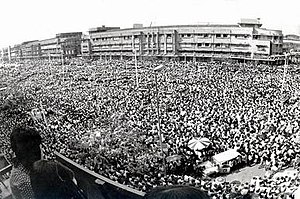| 14 October uprising | |||
|---|---|---|---|
 Thousands of students gather at Ratchadamnoen Avenue, 1973 | |||
| Date | 9 October 1973 – 15 October 1973 (6 days) | ||
| Location | Bangkok Ratchadamnoen Avenue | ||
| Caused by |
| ||
| Goals |
| ||
| Methods | Sit-ins, occupation of public avenues, protest march | ||
| Resulted in |
| ||
| Parties | |||
| |||
| Lead figures | |||
| Number | |||
| |||
| Casualties | |||
| Death(s) | 77 | ||
| Injuries | 857 | ||
| Damage | Buildings near Ratchadamnoen Avenue were set on fire | ||
The popular uprising of 14 October 1973 (Thai: เหตุการณ์ 14 ตุลา, RTGS: Hetkan Sip-Si Tula, lit. 'October 14 Event'; also วันมหาวิปโยค, RTGS: Wan Maha Wippayok, lit. 'Day of Great Sorrow'[1]) was a watershed event in Thailand's history. The uprising resulted in the end of the ruling military dictatorship of anti-communist Thanom Kittikachorn and altered the Thai political system. Notably, it highlighted the growing influence of Thai university students in politics.
- ^ Suwannathat-Pian, Kobkua (2003), Kings, Country and Constitutions: Thailand's Political Development 1932–2000, RoutledgeCurzon, p. 169